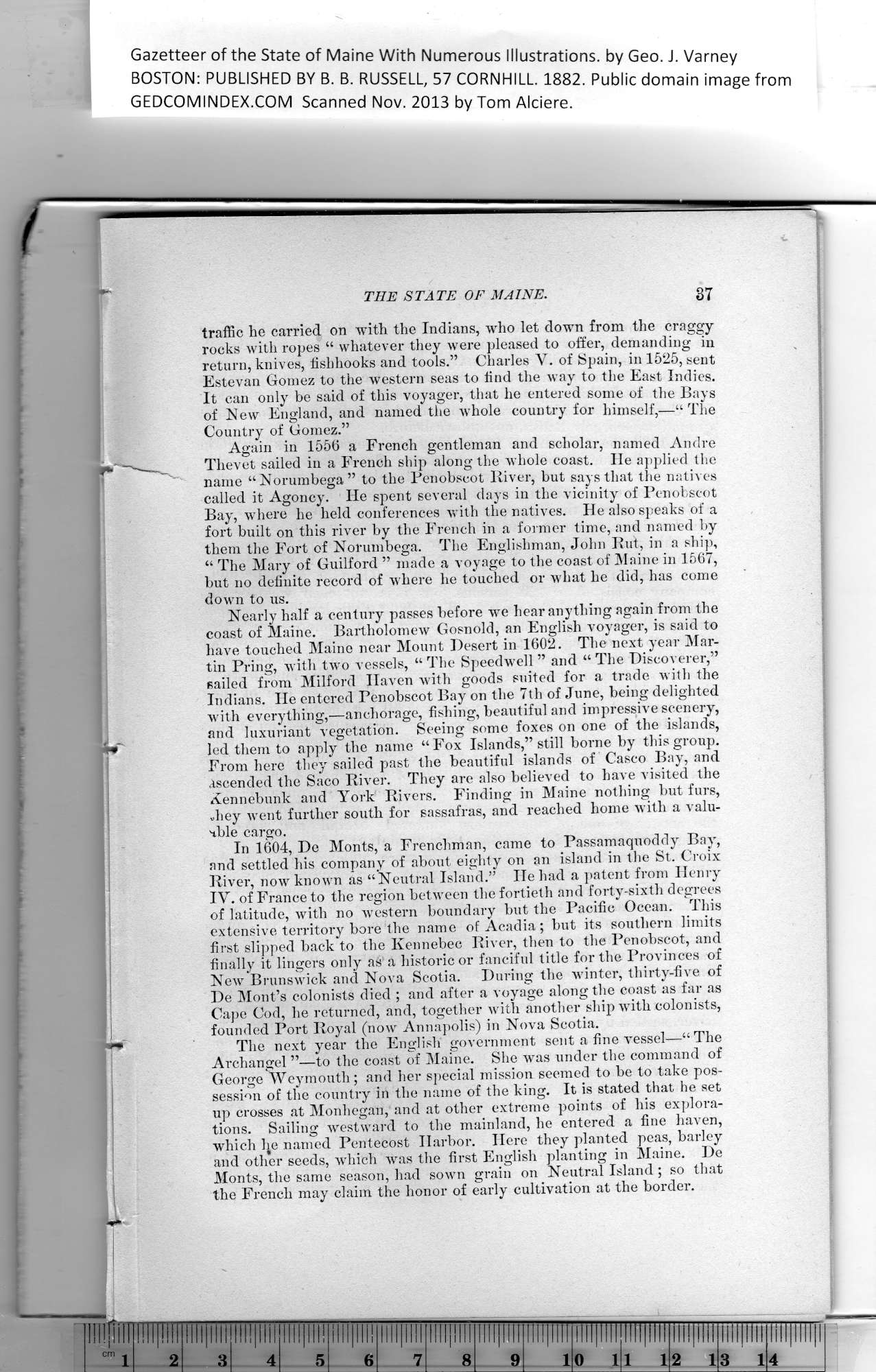|
Gazetteer of the State of Maine With Numerous Illustrations, by Geo. J. Varney
BOSTON: PUBLISHED BY B. B. RUSSELL, 57 CORNHILL. 1882. Public domain image from
traffic he carried on with the Indians, who let down from the craggy
rocks with ropes “ whatever they were pleased to offer, demanding in
return, knives, fishhooks and tools.” Charles V. of Spain, in 1525, sent
Estevan Gomez to the western seas to find the way to the East Indies.
It can only be said of this voyager, that he entered some of the Bays
of New England, and named the whole country for himself,—“The
Country of Gomez.”
Again in 1556 a French gentleman and scholar, named Andre
Thevet sailed in a French ship along the whole coast. He applied the
name “Norumbega ” to the Penobscot River, but says that the natives
called it Agoncy. He spent several days in the vicinity of Penobscot
Bay, where he held conferences with the natives. He also speaks of a
fort built on this river by the French in a former time, and named by
them the Fort of Norumbega. The Englishman, John Rut, in a ship,
“ The Mary of Guilford ” made a voyage to the coast of Maine in 1567,
but no definite record of where he touched or what he did, has come
down to us.
Nearly half a century passes before we bear anything again from the
coast of Maine. Bartholomew Gosnold, an English voyager, is said to
have touched Maine near Mount Desert in 1602. The next year Mar-
tin Pring, with two vessels, “ The Speedwell ” and “ The Discoverer,”
sailed from Milford Haven with goods suited for a trade with the
Indians. He entered Penobscot Bay on the 7th of June, being delighted
with everything,—anchorage, fishing, beautiful and impressive scenery,
and luxuriant vegetation. Seeing some foxes on one of the islands,
led them to apply the name “Fox Islands,” still borne by this group.
From here they sailed past the beautiful islands of Casco Bay, and
ascended the Saco River. They are also believed to have visited the
Kennebunk and York Rivers. Finding in Maine nothing but furs,
Jiey went further south for sassafras, and reached home with a valu-
able cargo.
In 1604, De Monts, a Frenchman, came to Passamaquoddy Bay,
and settled his company of about eighty on an island in the St. Croix
River, now known as “Neutral Island.” He had a patent from Henry
IV. of France to the region between the fortieth and forty-sixth degrees
of latitude, with no western boundary but the Pacific Ocean. This
extensive territory bore tbe name of Acadia; but its southern limits
first slipped back to the Kennebec River, then to the Penobscot, and
finally it lingers only as a historic or fanciful title for tbe Provinces of
New Brunswick and Nova Scotia. During the winter, thirty-five of
De Mont’s colonists died ; and after a voyage along the coast as far as
Cape Cod, he returned, and, together with another ship with colonists,
founded Port Royal (now Annapolis) in Nova Scotia.
The next year the English government sent a fine vessel—“The
Archangel ”—to the coast of Maine. She was under the command of
George Weymouth; and her special mission seemed to be to take pos-
session of the country in the name of the king. It is stated that he set
up crosses at Monhegan, and at other extreme points of his explora-
tions. Sailing westward to the mainland, he entered a fine haven,
which lie named Pentecost Harbor. Here they planted peas, barley
and other seeds, which was the first English planting in Maine. De
Monts, the same season, had sown grain on Neutral Island ; so that
the French may claim the honor of early cultivation at the border.
PREVIOUS PAGE ... NEXT PAGE
This page was written in HTML using a program written in Python 3.2
|
